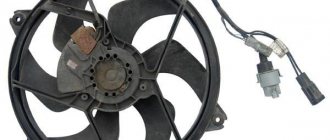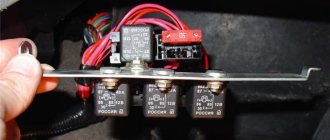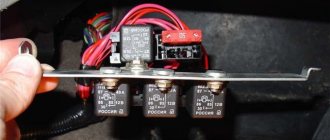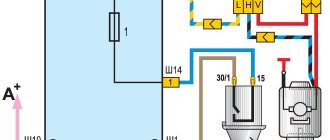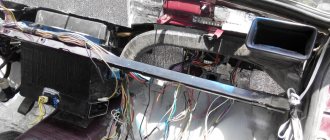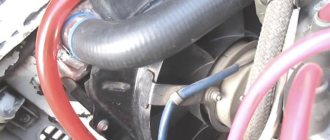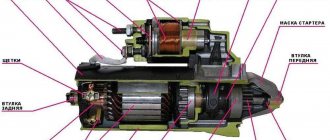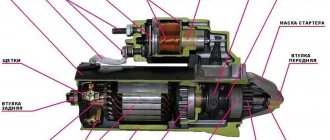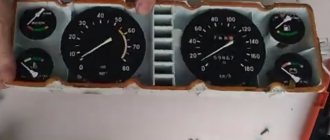Any internal combustion engine requires proper cooling. Without it, the motor will simply overheat, as a result of which the moving elements will instantly fail. The engines of modern cars are equipped with a liquid cooling system, which provides for constant circulation of coolant (coolant), achieved through the operation of a water pump (pump). Whatever coolant is used in the engine, prolonged heating will invariably lead to boiling. To prevent this process, a radiator is used in the cooling system. It is a system of thin tubes equipped with special lamellas that increase the area of the cooler.
When the car is in motion, the air flow hits the working surface of the radiator and passes between the lamellas, cooling the metal. Thus, the coolant temperature gradually decreases.
However, the radiator is not able to cope with overheating on its own, especially if the car is stationary or moving at low speeds. He is helped in this by an electric fan, which turns on automatically when the coolant reaches a certain temperature.
If it fails, the engine inevitably faces overheating with all the ensuing consequences. In this article, we will talk about possible reasons why the cooling fan does not turn on, as well as how to identify and resolve the related problems.
What is a radiator fan
To begin with, let us note that all the information provided is more intended for VAZ owners, although it can also be useful for drivers of foreign cars.
The VAZ cooling fan is an ordinary electric motor powered by 12 V from the vehicle’s on-board network. Its shaft is equipped with an impeller that generates a powerful air flow and directs it to the working surface of the radiator. The fan is mounted on a special frame (frame) to the front part. At the rear it is protected by a radiator grille.
Most VAZ cars are equipped with one fan. But there are also exceptions. For example, the NIVA cooling fan has two independent electric motors with an impeller that turn on simultaneously. This is necessary so that the engine of a domestic SUV cools faster.
How does the fan turn on?
The device turns on differently in different models. In cars with carburetor engines, it starts after the coolant reaches a certain temperature (105-107 0C) and the fan switch (not to be confused with the coolant temperature sensor), which sends a signal to the relay, is triggered. It closes the electrical circuit, supplying power to the electric motor.
The cooling fan circuit for cars with an injector is slightly different. Everything here is controlled by an electronic unit. Information from the switch-on sensor is first analyzed by the controller, and only then transmitted to the relay.
Possible fan malfunctions
If the fluid temperature has reached a critical value, but the radiator cooling fan does not work, it means that there is a problem somewhere. Our task is to find it and eliminate it. Let us indicate the most common malfunctions due to which the cooling fan does not work. There aren't that many of them.
- The fan motor has failed.
- The integrity of the wiring supplying the electric motor or connecting the fan switch sensor is damaged.
- Poor contact in the motor or sensor connectors.
- The cooling fan fuse has blown.
- The fan relay is faulty.
- The sensor is faulty.
- Malfunctions in the operation of the safety valve of the expansion tank.
Checking the electric motor
If the cooling fan does not work, the first thing you need to do is check its drive (electric motor). It's easy to do. It is enough to take two wires, connect them to the fan and power it directly from the battery. If it starts, then the problem is not with it. We need to look for it further. At the same time, you can check the contacts in the motor connector. Sometimes it happens that the problem is in them. The ingress of dirt and dust, as well as oxidation of metal surfaces can cause contact failure.
If the electric motor does not turn on after connecting to the battery, most likely it is the battery that has broken down. The reason for this may be:
- worn brushes;
- reservoir destruction;
- short circuit of the rotor or armature windings.
In the first case, it is enough to replace the brushes with new ones, and the fan motor will work like new again. In the case of destruction of the commutator or short circuit of the windings, repair may not help.
Checking the fuse and fan relay
If everything is in order with the electrical wiring, we move on to other equipment. First, let's check the cooling fan fuse. It is usually located in the mounting block under the hood of the car and is marked F7. We check it with the same car tester. If the fuse is good, move on. We are looking for the fan switch relay. It is located under the cover of the right panel of the center console. There are three relays located there. The car owner's manual will help you determine what you need, since different models have different locations.
But how to check the relay? In field conditions, it is almost impossible to determine its performance. It’s easier to take an adjacent relay (if its parameters match) and install it in the desired slot.
Brand tour
Most motorists prefer non-original engine fans from the following companies:
- Bosch (Germany);
- Denso (Japan);
- Topran (Germany);
- Luzar (Ukraine);
- Nissens (Denmark);
- Febi (Germany).
Even more affordable analogues are offered by the following companies:
- JP Group (Denmark);
- Polcar (Poland);
- Termal (Taiwan).
We advise you to buy a more expensive analogue made in Europe or Asia, as it will last you longer. You can also take domestic radiators, as long as they match the characteristics and have the appropriate geometry.
Testing the fan switch sensor
The next reason why the cooling fan does not work may be a faulty sensor. Cases of failure of this element are not so rare. It is possible to accurately determine that it is the sensor that has broken down only in a car with an injection engine. If you disconnect it from the power supply, the electronic control unit will perceive this as a system malfunction and start the fan in emergency mode.
The check is carried out as follows. We warm up the car until the coolant temperature reaches 100 0C, then turn off the engine, lift the hood and disconnect the sensor by disconnecting the connector on it. After this, we start the engine. If the fan turns on, then the problem is with the sensor.
Unfortunately, such a check is not possible in cars with carburetor engines. Here, you can determine the functionality of the fan switch sensor only by replacing it with a new one and warming up the engine to operating temperature.
Diagnostics
Before trying to determine why cooling system fans may turn on when the engine is cold in cars, it is recommended that you understand the operation of this unit.
The fan is turned on due to the operation of a special sensor, which activates the rotation of the blades. This controller is located at the bottom of the cooling radiator.
There are some modern cars where the engine control unit is responsible for starting, although this is rather a rarity and the exception and the rule.
When the cooling liquid (coolant) reaches the required temperature, which is usually in the range of 100-105 degrees Celsius, the sensor closes the electrical circuit, and this allows the fan to turn on. It starts blowing on the radiator. This achieves a better cooling effect, since the air and liquid systems are combined.
At the same time, there are situations when the engine is still absolutely cold, it does not require any additional cooling, but the fan still turns on. This is not a normal condition. It is necessary to look for the reason for this behavior of the cooling system and eliminate any malfunctions that have arisen.
If you continue to ignore the constantly running fan, the initially simple discomfort will give way to more serious problems.
But here it is important to note that the constant operation of the blades is not as dangerous as a complete failure of the device. Although this fact is absolutely not a reason to do nothing
It all starts with diagnosis. The simplest and most convenient in this regard are injection engines. To detect a malfunction, it is enough to conduct computer diagnostics. This is done both in a car service center and in the garage with your own hands.
Connecting to an electronic control unit makes it possible to obtain error codes that are not difficult to decipher and understand the true reasons for this behavior of the cooling system fan.
There are situations when the ECU detects a malfunction in the cooling system and causes the fan to spin constantly, even when the engine is cold. This is a kind of protective function aimed at preventing possible overheating of the internal combustion engine. Therefore, when errors are detected and after troubleshooting, a reset is required. To erase errors, you should look at the owner's manual for your car. On some cars, it is enough to remove the terminal from the battery, and the errors will be erased. On other cars, errors are erased using connected diagnostic equipment.
If the option of computer diagnostics does not suit you or it cannot be used for one reason or another, you will have to use the method of elimination to check all potential sources of trouble.
Changing the safety valve
There is another malfunction that can lead to system failure. If the cooling fan does not work even after confirming the operability of all the listed elements of the chain, it is worth checking the safety valve on the expansion tank.
The role of this valve is to maintain the operating pressure in the system above atmospheric pressure. This is necessary so that the water included in the coolant does not boil when heated to 100 0C. If the safety valve fails, the pressure in the system will equalize with atmospheric pressure and the liquid will boil, reaching the boiling point of water.
The switch-on sensor, as already mentioned, can only turn on at 105-107 0C. Thus, our coolant will boil, but the fan will not work.
How to check the safety valve? This is impossible at home. It’s easier to buy a new valve, especially since it costs pennies.
Confinement of mass
The functioning of the fan depends on different methods, as you have already seen from reading this article. There is another reason that disables the fan's performance. For example, if the corresponding wires are poorly screwed to the body, the fan is connected directly to the battery. It should be noted that in this case, it is necessary to take timely measures to avoid serious problems.
With this option, you can expect the car to catch fire. If a strong short circuit occurs, then all the wires will heat up accordingly. To avoid serious consequences, you should check the connections and wires that have access to the sensor. Reliable fastening of wires and intact insulation reduces the risk of serious consequences.
Useful tips
Finally, check out these useful tips that will allow you, if not to avoid problems with turning on the cooling fan in a timely manner, then at least to correct the situation a little.
- Systematically check the operation of all elements of the cooling system. Pay attention to the coolant temperature indicators on the instrument panel, and also listen to whether the fan turns on.
- Monitor the coolant level in the system. Replace it in a timely manner.
- At least once a year, wash the expansion tank cap under running water. This solution will extend the life of the safety valve.
- If there is the slightest malfunction in the cooling system, stop driving and take corrective action.
- If the cooling fan does not work due to a sensor, fuse or relay failure, and this malfunction caught you on the road, disconnect the sensor (for an injector) or connect the electric drive directly to the on-board network (for a carburetor). This way you can drive to the nearest service station without the risk of engine overheating.
Modernization
If you want to improve the operation of your radiator fan on the VAZ 2109, we offer the appropriate instructions.
To upgrade, you will need to install a second sensor and modify the system somewhat.
- The standard power sensor will be responsible for the operation of the fan at maximum speed.
- An additional sensor will include a reduced speed. It is installed at the top of the cooling system.
Now let’s talk more specifically about how to organize all this.
- Take a temperature sensor whose response temperature is similar to the standard regulator.
- Install it in the upper pipe fitting to the radiator.
- To mount the element, you will need a pair of washers and a nut. Be sure to lubricate the washer with sealant to prevent leakage from the installation hole.
- Buy a resistor to install on the stove fan. It has several outputs, so if desired, you can make several operating speeds.
- It is necessary to make an additional control circuit. Through it, less voltage will be supplied to the motor winding.
- The temperature sensor located in the upper part of the cooling system is responsible for turning it on.
- It is better to do control not by plus, but by weight.
- The system will work through a button in the cabin. To the left of the dashboard there is a grille with two plugs. Cut out one of them and set it to turn off on two modes. You can take the heater switch from a VAZ 2107.
- In the first position the low frequency will be switched on, and in the second – the maximum speed.
- One common wire is fed to the minus.
Such modernization is not provided for by the design of the VAZ 2109. These are modifications made by car enthusiasts. Therefore, installing a second sensor is entirely your personal responsibility.
The fan is an important component of the cooling system of VAZ 2109 injection and carburetor engines. If you wish and have time, you can easily replace or repair it yourself.
- Original German autobuffers Power Guard Autobuffers - save money on suspension repairs, increase ground clearance +3 cm, quick and easy installation...
Official website >>>
On the way, you notice that the fluid temperature gauge needle has crossed the red mark and is steadily moving further. We urgently stop, raise the hood: that’s right – the fan blades are motionless. How to fix the breakdown and get home? Read more about this.
